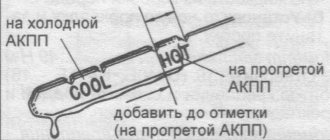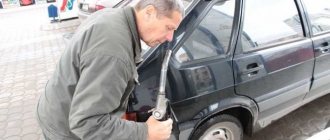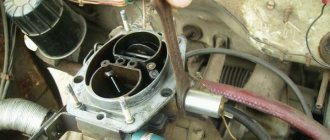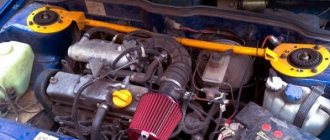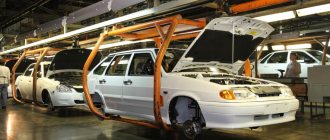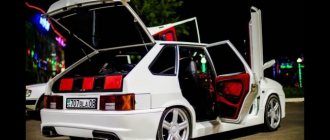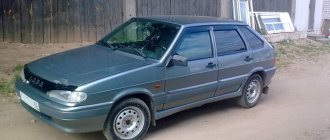Problem of supplying the engine with fuel and air mixture
A too lean air-fuel mixture is a fairly common problem that leads to serious engine malfunctions. Errors and disturbances in the mixture formation process can occur on carburetor or injection engines, as well as on power units with additionally installed gas equipment.
One of the main signs that shows deviations from the fuel assembly norm is unstable engine operation at low and idle speeds. As a result, the car begins to jerk and stall when starting to move.
For example, if a lean mixture is constantly supplied to the cylinders, the consequences can be quite serious. In a number of cases, the appearance of a white coating on the spark plugs and misfires have been noted; a lean mixture causes local overheating, burnout of valves and melting of the pistons.
General diagnostics of deviations from the fuel assembly norms begins with the ECM sensors. Typically, the P0171 code occurs due to a malfunction of the MAF sensor (mass air flow sensor). The fact is that the specified sensor ceases to respond in a timely manner to changes that relate to air flow. The cause is usually an accumulation of contaminants.
A poor fuel assembly of a car is the main reason why the car starts to twitch at low speeds
In this case, the control unit automatically reduces the fuel supply so that the amount of air increases. The result is a lean mixture at different operating modes of the power plant. After this, error P0171 occurs; in parallel, error P0100 or P0102 can be detected. Such codes usually indicate problems and malfunctions in the mass air flow sensor.
Opel Astra
A common problem is the appearance of jerking while driving an Opel Astra. In this case, the malfunction most often appears after the engine has warmed up to 50 degrees Celsius.
The first thing to do is to carry out diagnostics and count errors. During the assessment process, it is necessary to look at the injection timing and EGR sensor/valve performance.
After that do the following:
- Warm up the engine to operating voltage.
- Check the voltage at the EGR contacts (there are five in total). To solve this problem you need to use needles. There should be about 14 V on the outermost contacts, about 5 V on the second one from the windshield, and on the third one there should be from 0.65 to 2.0 V.
- Check the wires that go to the EGR.
- Make sure the valve is intact. Perhaps it has malfunctioned.
- If the valve and wires are intact, only the ECU remains. It is necessary to open the block and see what problems there are.
Incorrectly set car ignition
Incorrectly set ignition is another common reason why a car starts to jerk at low engine speeds.
Signs of early ignition, as well as late, imply an advance or delay in the operation of the “ignition” system in relation to the position in which the piston is located in the cylinder. In other words, the spark plug ignites the fuel-air mixture not at the most optimal moment for this, but earlier or later.
This became the reason for the fact that in cars in which it is possible to adjust the ignition timing independently, car enthusiasts are often faced with the need for correct settings. How to determine whether ignition is late or early? The following is a list of signs by which an incorrectly set ignition is determined:
- Difficulty starting the power unit.
- The engine overheats and detonates.
- The accelerator pedal becomes less responsive.
- Unstable idle.
- The power potential of the engine is reduced, and throttle response is also lost.
Fuel consumption increases significantly. An incorrect OZ can also show itself in the form of specific pops that are heard in the carburetor, in the exhaust system, etc.
This leads to a very obvious conclusion: further operation of a power unit with incorrect safety regulation can lead to more serious consequences. The consequences will be especially negative if detonation occurs regularly.
Checking filters
The fuel system of a modern car is equipped with at least three filters. The first of them is, in fact, just a mesh that serves to trap solid particles. It is placed in the neck of the tank, but it is not capable of becoming clogged to such an extent that fuel does not enter the cylinders. In this regard, this filter cannot be the reason that the VAZ-2114 twitches when driving.
The other element is mounted on the fuel pump, which is submerged in the tank. This is the same grid, only with smaller cells. However, the functions are basically the same - to retain large debris. For this reason, it is also clear that it is also not capable of becoming very clogged.
The third element is located after the fuel pump, and it is this filter (it serves for fine cleaning) that can become so clogged that the pump will one day stop coping with its duties.
At the same time, some models may have several additional filters installed. And they may well cause the car to jerk.
Damage to the accelerator (gas pedal)
Mostly, problems with car jerking at low speeds are associated with electrical circuits. The pedal support is equipped with a pair of sensors. Their task is to transmit signals for changing the accelerator position.
There is an indicator on the panel that will indicate a system malfunction. If one sensor is damaged, the engine speed increases at a low speed. If both devices break down, the emergency mode is activated and the engine runs at idle.
As a result of a breakdown, the pedal must be replaced, since the sensors cannot be restored. Loss of wiring integrity leads to a malfunction of the throttle. If the electric motor becomes unusable, the information on the monitor will display an error indicating an accident. These problems can be easily solved. If the accelerator of the electronic gas pedal breaks down, it is replaced with a new one.
The need for balancing
Neither tires nor wheels are perfect in terms of geometry and composition. So, due to different masses in different parts of the wheel, those places where the weight is greater will pull the wheel axle towards themselves. At high speeds, the force will be transmitted to the rods, then to the steering wheel.
It is very important to perform balancing from time to time. Especially after changing tires or wheels. Using this procedure, you can equalize the masses of the wheels at each point. Driving a vehicle with unbalanced wheels can cause rapid wear on the chassis and suspension, a problem that is more difficult to correct.
Why does the car jerk while driving?
Various malfunctions associated with the operation of the engine, transmission and attachments can occur both at idle and under load while driving, as well as in transient modes. Failures can often be identified by the presence of obvious leaks of technical fluids, increased noise, obvious knocking, unstable operation of the internal combustion engine, failures, etc. Next, we will look at the possible reasons why a car with an injector begins to twitch while driving, that is, noticeable jerks appear.
What to do if there is vibration in the cabin at idle VAZ 2114
Have you ever experienced vibration in the cabin when idling your VAZ 2115? If a person has been driving this car for several years, then the chance of this happening is very high. This problem is widespread not only in cars of this model, but the VAZ 2114 also often suffers from this problem. Some drivers simply try to ignore the discomfort.
But vibration in the cabin is not a problem that can be ignored. If the car body shakes at idle, this is a sign of a malfunction, due to which the car may stall right in the middle of the road. This insidious problem loves to hide deep inside the engine, so much so that not every auto mechanic can immediately determine what’s wrong. But this does not mean that the problem cannot be fixed. The main thing is to know where to look.
Fuel system problems
If the car jerks while driving, then diagnostics should begin with the fuel system. The main symptoms of malfunctions in the engine power supply system are jerking of the car in motion. These signs of failure appear in several situations.
There is a need to accelerate sharply. At this moment, the driver presses the gas pedal hard, but the desired pickup does not occur. Instead, the car jerks and then begins to accelerate with or without further jerks. It is also possible that jerking begins after releasing the gas. The problem occurs when the car suddenly jerks while driving at cruising speed.
In other words, dips and jerks in the operation of the internal combustion engine can be noticeable both when the crankshaft rotation speed changes (during acceleration and releasing the gas) and at constant engine speeds (the gas pedal is in one position). The first step is to eliminate the possibility of refueling with low-quality fuel, airing of the fuel supply system and leaking fuel lines. The next element that requires monitoring is the fuel filter.
If its throughput decreases, the engine will not have enough fuel, especially with a sharp increase in speed and an increase in the load on the power unit. You also need to make sure that the air filter is not significantly dirty. Having ruled out the above reasons, you need to proceed to checking the injector. To obtain accurate results, the fuel pressure in the fuel rail (rail) is measured, and the performance of the injectors is checked.
Low pressure in the fuel rail leads to the fact that at the moment of a sharp press on the gas, the throttle valve opens wide; the throttle position sensor sends a signal to the ECU. With reduced pressure, the electronic control unit is not able to quickly provide the required volume, as a result of which the car begins to jerk while driving.
The next step is to check the electronic sensors using a tester (multimeter). The main list contains:
- idle speed sensor (IAC);
- throttle position sensor (TPS);
- camshaft position sensor (CPR);
- mass air flow sensor (MAF);
It is worth noting that dips and jerks often appear when starting to move (when the engine leaves the idle mode). At this moment, the throttle valve begins to open, and the throttle position sensor transmits a signal to the ECU. The control unit begins to increase the fuel supply to ensure a smooth transition to operating mode under load. At low pressure in the fuel rail, as well as in the event of TPS malfunctions, the car will jerk in this transient mode.
Additionally, it is worth paying attention to the throttle valve itself, since this element can become very dirty during operation. Contamination leads to system malfunctions, which can be eliminated by mechanically cleaning the throttle. It is recommended to clean the throttle valve at every maintenance for preventive purposes. Another element that will require checking if the car jerks while driving is the fuel pump. It is necessary to check the device for operability, and also to exclude the possibility of severe contamination of the fuel pump mesh.
Idle speed sensor
When the driver feels his vehicle begin to jerk, it makes sense to check the condition of the idle speed sensor. At the same time, such a malfunction is very difficult to identify, since often the well-known Check Engine indicator simply does not appear on the dashboard.
For this reason, it is worth checking it first. In this case, the nature of the malfunction may be different. Firstly, the sensor is contaminated with oil, dust, and crankcase gases. Secondly, you should not discount the mechanical nature of the damage - the rod, threaded connections, rivets flying out and other cases. Thirdly, this is a failure of the electrical part.
Problems in the ignition system
The engine may also run unstably and jerk while driving if there is a problem with the ignition system. In addition to jerking, there is a loss of power, increased consumption, etc. An independent test involves diagnosing power wires, spark plugs, ignition coils, and DPRV.
To detect a possible cause, it is necessary to turn off the ignition, after which the reliability of fastening the high-voltage wires to the coil and spark plugs is checked. Next, the engine starts and its operation is assessed by ear. Special attention should be paid to the peculiar “crackling” sounds that can occur as a result of a spark breaking through in some area.
Such deposits are removed mechanically using a stiff brush. If the car does not stop jerking after cleaning or replacing the spark plugs, then it would be a good idea to check the camshaft position sensor with a multimeter.
How to prevent this?
The following tips are a little banal, but effective. At a minimum, you need to fill your car with high-quality gasoline with the correct octane number. The instructions for the car must indicate what fuel should be poured into the tank.
This also applies to oil. It is necessary to use only the lubricant recommended by the manufacturer. Taking into account the presence of counterfeit oils on the market and low quality fuel, it is necessary to change oils even more often than the car manufacturer recommends. At a minimum, after 8-9 thousand kilometers the lubricant must be replaced. This will extend the life of the motor.
In general, you need to operate the car carefully. If you put a heavy load on the engine at least once and heat it up to the “red zone” on the thermometer, then problems with the engine can arise constantly. In this case, jerking when starting is far from the worst problem.
Other reasons
Among other possible reasons that can cause the car to jerk when driving, it is necessary to highlight possible problems with the clutch on “mechanics” and malfunctions of automatic transmissions. As for manual transmissions, jerking may occur after changing to a certain gear at the moment the driver begins to release the clutch pedal. In this case, you should start by checking the condition of the basket, clutch disc, release bearing, etc.
Finally, we would like to add that noticeable jerks when braking are mistakenly taken by some drivers for malfunctions of the internal combustion engine. In fact, a common reason for this behavior of a car can be worn out brake discs.
Defects that appeared after replacing the clutch
What does it mean to replace the clutch? This action means changing the driven or driven clutch disc; often both parts are changed at once. In this case, the release bearing must also be replaced. After such an operation, side defects are suddenly revealed that were not there before the repair.
If we think logically, then there are few reasons for the appearance of new malfunctions. Typically this is:
- Unqualified repairs;
- Defect of new spare parts;
- Erroneous diagnostics, as a result of which not all or the wrong parts were replaced, and previously hidden problems manifested themselves in full.
In general, the issue of the appearance of new unpleasant signs is very difficult and is individual in each specific case, but these signs have common characteristic features.
WHAT CAUSES THE MACHINE JERKING DURING WORK AT LOW RPM?
The main systems in which problems often lie:
- Fuel supply system to the engine;
- Auto ignition system;
- Gearbox, both automatic and manual;
- Distributor;
- Fuel filter system;
- Sparking system;
- Car computer control unit.
If you hear the brakes squeaking when twitching, this may indicate the appearance of several, both interrelated and completely independent problems.
"Personal" motives
The cases listed above are the main reasons why the steering wheel twitches when driving a VAZ-2114. Moreover, this is observed when starting or accelerating. However, it should be taken into account that each vehicle has individual characteristics, which are comparable to the human body.
In other words, each car has its own “diseases” and the appearance of the “symptom” in question is precisely due to the presence of design flaws.
The VAZ 2114 starts to twitch when you move away and when you press the gas slightly. It all starts when the engine is heated to operating temperature. I thought it was a problem with the filters. Changed the gasoline filter and cleaned the fuel system. Maybe it's the box? Has anyone had this problem?
DIAGNOSTICS
Checking the systems of domestic cars such as Lada Priora, 2110 is relatively simple, which makes it possible to perform the operation yourself. If there is such a malfunction or the vehicle jerks during acceleration, you should first check such components.
- Fuel lines and injection system. It is necessary to look for microcracks, defects through which air can be sucked into the system. The fuel pump is checked separately.
- Air filter. Some car enthusiasts neglect this unit, but the source may be hidden here - a clogged filter does not allow sufficient oxygen to pass through, which provokes tremors.
- Ignition system. This is done from spark plugs - the part is unscrewed from the socket and the body is pressed against the surface of the internal combustion engine block. At this time, you need to turn on the ignition - the task is to detect a powerful spark. If there are no current breakdowns, you should move further along the circuit to the computer or distributor. This algorithm is also relevant for other domestic cars, for example Daewoo Nexia or Lanos.
- If no problems are found in the main engine systems, the clutch disc should be examined. Usually, when a pad wears out, jerky acceleration or jerking of the car occurs at low throttles.
If a car enthusiast encounters a problem on imported, complex cars such as the Hyundai Solaris or Toyota Corolla, it is recommended that diagnostics be carried out in specialized workshops. Do-it-yourself repairs can only make the situation worse.
DEEP CHECK OF POWER OPERATION WITH INJECTOR AND CARBURETOR
If signs of shaking at low speeds appear, a priority check of the engine system is required. So, owners of the first type of car should start by diagnosing the gasoline pump, since it breaks down quite often. As a result, at low speed there is a pattern when it supplies insufficient fuel and the engine stops working for a short time. The most common breakdown in this device is caused by a loose o-ring on the valve or the device itself breaks down.
Fuel lines are another element that requires special attention from the car owner. The most common problem with them is a leak. Clogging is common. They can be solved by sealing them back and cleaning these lines, but even better - by replacing them. In parallel with the fuel lines, it is worth checking the injectors and throttle valve, the normal operation of which is hampered by carbon deposits and dirt, leading to interruptions in the supply of gasoline.
Injection engines require annual cleaning of injectors and throttle valves. Fuel filters should also be checked regularly, as their clogging causes interruptions in the flow of the fuel-air mixture.
The easiest way to check the pressure in the fuel line of carburetor and injection engines looks like this: cut off a piece of the hose and connect a pressure gauge to the line through this section. If it shows 3 kgf/cm. sq., then everything is in order with this parameter. Cars with an injector also have their fuel quality checked, as they are very sensitive to this.
CHECKING THE IGNITION SYSTEM OF THE CAR
One of the most common reasons why a car starts to twitch. Due to an incorrectly functioning ignition, the combustible mixture in the cylinders ignites at the wrong time when needed. Diagnostics of ignition operation includes checking:
- Ignition coils;
- Engine spark plugs;
- High voltage wires from spark plugs;
- distributor;
- Camshaft and crankshaft position sensor (CPR):
- Switch.
The interconnectedness of different elements of the ignition system leads to the fact that the failure of one part affects the inoperability of the whole.
CANDLES AND WIRES - PROBLEM NUMBER ONE
Any check starts with them. Most often, failures in engine operation are observed when they are contaminated with carbon deposits. Because of the latter, gaps in the formation of sparks occur and ignition of the combustible mixture does not occur in a timely manner. The cheapest way to solve the problem is to clean the spark plugs yourself. If the car owner can afford it, it is wiser to immediately replace them with new ones; the appearance of carbon deposits indicates an imminent need for replacement.
SENSORS - CHECKING THE ELECTRONICS SYSTEM IN THE CAR
Failure of any such device can lead to problems. Problems with some of them will cause the car to twitch. Responsible for this may be:
- Throttle position sensor, which often breaks if a non-original model is installed;
- Absolute motion sensor, responsible for smooth engine speed and stable operation;
- Idle speed sensor, which usually breaks due to poor quality fuel;
- Sensors responsible for fuel economy and environmental friendliness.
It is recommended to pay special attention to the lambda probe, the failure of which leads to increased fuel consumption and is difficult to diagnose even by experienced technicians.
CHECKING THE CAR TRANSMISSION
Clutch problems are a fairly common reason why the car starts to jerk at low speeds. In most cases, the springs that are responsible for the smooth transmission of torque fail. For some models, an uneven ride is a symptom of the need to lubricate the release bearing fork. Hondas especially suffer from this.
For automatic transmissions, jerking when starting to move is a bad sign of imminent failure. The car owner is recommended to contact a service station at the first symptoms.
TRANSMISSION
Most often, symptoms of this kind occur when, in the presence of an automatic transmission, the transmission fluid is not changed for a long time. Or they do not carry out mandatory gearbox repairs after 200 thousand kilometers.
You should not attempt to repair the transmission, as well as the entire automatic transmission system, yourself, but rather contact a certified service center. This is due to the fact that this system breaks down quite easily and errors during intervention can cause future expensive major repairs.
PROBLEMS IN THE ACCELERATOR
Pressing the pedal too hard in modern models can cause the car to start behaving strangely. This is due to the fact that the engine sharply increases the number of revolutions, which is why the load on the vacuum ignition angle regulators increases and they cannot withstand them.
When the car switches to low speeds, the distributor begins to sink. And the next time you press the gas, the increase in speed occurs with a delay, which already affects the throttle valve. The flow of the combustible mixture increases, and it does not have time to burn, damaging the ignition timing bearing. That is, as you can see, just one mistake in driving can lead to a whole chain of unpleasant consequences.
The best way to find out if the problem is actually related to the accelerator is to check the vacuum regulators. To do this, disconnect the hoses and pipes from them, covering the holes with your hands. While the motor is running, a vacuum effect should occur, accompanied by a clear retracting sound. Its absence is a sure sign of a breakdown.
CLOGGED OR FAULTY INJECTORS
Clogging can be easily removed by flushing the fuel system. But, if the injectors are worn out, then the only way out is to replace them, which can also be done with your own hands.
THE DAMPER IS CLOGGED, THE AIR CLEANING SYSTEM IS DEFECTIVE
The throttle valve can become clogged no less often than the injectors, with no less consequences. In particular, this causes interruptions in the supply of the fuel-air mixture. Cleaning the damper is quite simple, so it is recommended to perform preventive cleaning at least several times a year.
WEAR OF UNIT PARTS IS A SAD CAUSE OF JERKING
A barely noticeable twitching of the car at low speeds or increasing load can be a sign of a dangerous problem - wear of engine parts. This is sad because it can be a real blow to the car owner's budget. You should not start by checking this malfunction, but if the diagnostics do not reveal any other problems, you should be prepared for it.
A full check of the power unit consists of several stages:
- Computer diagnostics, which will allow you to identify all errors within a few months.
- Checking driving characteristics with the help of an engine mechanic who can determine the capabilities of the engine by external signs.
- Disassembly of the power unit, if the mechanic has a reasonable suspicion of a malfunction.
- Diagnostics of a disassembled motor to determine a specific breakdown.
Problems can range from something as simple as broken rings to something as simple as a crankshaft that requires disassembly of the entire unit. The most expensive malfunction is the breakdown of the piston group. It is worth considering that specific breakdowns can only be determined by disassembling the engine and if they promise you something different, then most likely it is a hoax.
BAD FUEL
The reason for the jerking of the car does not always lie in the breakdown of one or another of its parts. Sometimes it lies simply in the use of low-quality or unsuitable fuel. It is not necessary that gasoline is bad in itself; water ingress can cause problems and the engine will not be able to “feed” normally on it. The best solution is to drain the low-quality fuel and fill it with good fuel.
If there is a knocking noise after replacing the clutch
As a rule, the cause of knocking after replacing parts is defective parts. In particular, there are dangling damper springs in the driven disk. Therefore, before installing such a spare part on a car, you need to carefully inspect it. Parts of the disk may also be poorly riveted. » alt=»»> Knocks in the clutch area can occur due to a crack in the release bearing bushing (the bushings are often made of plastic). Even at the site where the bushing fits on the flange of the gearbox input shaft, play may form, which also leads to a knocking sound.
A CAR WITH AN INJECTOR DRIVES JERKYLY AT SMALL THROTTLES
If a VAZ 21099 injection-type car jerks while driving, the cause may be several components. In this case, it does not matter whether the engine has 8 or 16 valves.
The first step is always to check the ignition and the supply of fuel to the cylinders. If everything is working normally, it is recommended to perform diagnostics of the injector by purging the injectors, the fuel rail and checking the pressure in it. It is also necessary to remember about the mass air flow sensor - a small device can significantly upset the balance of the entire structure. If a defective part is discovered, it is replaced with a known good one (new).
Additionally, experts recommend checking temperature sensors. The sequence of actions is relevant for the entire generation of VAZs, including models 2107, 2112.
Vibration that occurs after replacing clutch elements
There are few reasons why vibration occurs after replacing a clutch. Vibration usually appears in two forms:
- The pressure plate (clutch basket) is not balanced;
- During assembly, the driveshaft was installed in a different position from the original installation (but this only applies to rear-wheel drive or all-wheel drive vehicles).
By and large, on cars with front-wheel drive, you can inaccurately secure the wheel drive (CV joint), and the movement of the car will be accompanied by vibration and knocking, but this does not happen often.
If the clutch basket creates vibration, you can try moving it to a different position. As a rule, the pressure plate mounts are symmetrical. On many models, the basket is attached to the flywheel with six bolts, and the basket can be placed in three positions. In one position the vibration may disappear completely or be minimal. But it is better to exchange the warranty part immediately for another one. This will be less hassle for the car owner.
The problem is this: uneven operation of the engine at idle, and jerking when starting off (The sensors are all changed, I had electrical diagnostics - everything is smooth. Compression is 1,2,4 - 10.5 in 3-8.5. It runs well after 2000, at speed 3 yesterday I accelerated from 40 to 110, it drives without hiccups. Has anyone had this happen? Video for clarity (when you press the gas, the sound near the mass air flow sensor is similar to air leaks). It jerks when starting off the VAZ 2114.
Similar articles
24 comments on “The VAZ 2114 jerks when starting. And jerks when starting”
Have you adjusted the valves recently?
Start with a description of the car! Lack of description in the TEXT is not respect for the reader. Measure the MAF ADC
Olga, this is a lottery for a couple of seconds. According to the rules in your stream
What is there to describe? VAZ 21093 approximately 2002 1.5 8kl engine works like a tractor
Egor, VAZ 2114 1.5 8 cells. 2004
You need to look at the valves
Maybe the firmware
Rasim, valves and air leaks. You can also check the spark plugs and wires
Spark plug, wire, module, or gasket burnt out. Or the belt jumped onto a tooth, or maybe the fuel filter turned into shit
Egor, could it be from a clogged fuel pump screen or a dying ignition module?
Rasim, perhaps both the mesh and the air flow sensor are dying. Measure the MAF ADC. If there was a module, the car would be very slow when accelerating
I had it because of the module and once because of a clogged throttle
DMRV has nothing to do with it! He says that he did the diagnostics
Rasim, the module has 2 failure options: 1st, 2 pots turn off... 2nd, all pots turn off for a short time
Guys, the question is, what could happen to the alarm? I set the doors to not close?
Mikhail, were there any jerks when starting off and after switching? Now, to get moving, I give it 2000 rpm so as not to stall. Yes, and you can hear small pops from the muffler
Egor, the gap with dips appeared gradually after changing the fine filter, which is located next to the tank. Also, when you open the neck, you can hear the pressure being released, then this did not happen! The funny thing is that before this there was another problem with XX, often the speed on the contrary rose to 1200-1400, but did not float.
The mileage of 120t itself had a similar problem. As a result, three exhaust valves have a gap of 0.15 when the norm is 0.35, that’s the whole reason
Rasim, it looks like there's something wrong with the gas supply. Check the mesh, tank ventilation, pump pressure...
Igor, is the firmware broken?
It was exactly the same. I washed the throttle, changed the spark plugs, and reset the brains, now everything is fine. I don’t know what I did that helped. Aren't the candles black by any chance?
Rasim, the adsorber purge does not work because it squeaks. I'm in trouble right now. The current kpa was stuck in the open position and was leaking from it. So the traction dropped a little. Start with the valve clearances. Measure it or drive it to a hundred. Why am I driving them, you can hear a knock in the video. But the video won’t convey the whole picture)
A CAR WITH A CARBURETOR JERKS AT LOW RPM
To reduce the length of the text, our editors omit standard checks of the transmission, lines and ignition. If all systems are functioning normally, but the jerking continues, reconfiguration and carburetor cleaning are required. This is important, since a small speck that gets into the nozzle can completely upset the calibration of the unit.
The unit is dismantled and wiped clean of dirt. Next, you need to sequentially disassemble the entire system and thoroughly rinse it from possible debris with clean gasoline. After cleaning, all internal passages and inserts are purged with a compressor, which guarantees 100% cleanliness.
The last step is reassembly and installation on the engine.
VAZ 2109/08/99 and 21074 carburetors are especially sensitive to such “sores”.
Replacing pillows and preventing spark plug malfunctions
It is worth learning to deal with the most common causes of body vibrations: engine mounts and spark plugs. In the first case, replacing parts cannot be avoided - the rubber from which the parts are made simply wears out and loses its elasticity. There's nothing you can do about it. Replacing pillows is similar to other car models and should not cause problems. To replace you will need:
- Socket wrench 17 with cardan.
- Socket wrench 13.
- Keys for 15 and 19.
- Hydraulic jack.
If replacing parts yourself causes you difficulties or you lack the necessary tools, the best solution would be to contact a car service center. At the same time, you can select the pillows you need in advance, so as not to wait for mechanics to find them and order them for you.
However, spark plugs, unlike engine mounts, can avoid replacement for a long time if they are properly cared for. If you regularly clean them and monitor the gap between the electrodes, you can significantly increase the period of stable operation without uncomfortable vibrations of the case.
In addition, you need to monitor the appearance of carbon deposits on the cone.
Excess oil in the crankcase, insufficient vehicle load, early ignition - this may be indicated by different colored soot on the spark plugs. Paying attention to this detail can greatly help you diagnose problems.
DIESEL CAR JERKS AT LOW SPEEDS
In addition to the above problems, diesel engines also have a malfunction of the high pressure fuel pump. This part of the line is responsible for the direct supply of the combustible mixture into the combustion chamber. As a rule, a malfunction is caused by clogged cavities, breakage or wear of the working part of the part.
To eliminate twitching, it is enough to clean the inside of the unit. If oxidation has reached a critical point or there is a serious breakdown or wear, the device is completely replaced.

